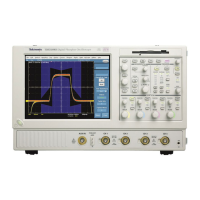306
The instrument acts on Force Trigger even if selected before the end of pretrigger holdoff.
However, the button has no effect if the acquisition system is stopped.
Triggering on a Glitch
Use this procedure to detect and trigger on a glitch or to ignore a glitch.
Select glitch triggering
1. Push the front-panel ADVANCED button.
2. On the Trigger Setup control window, select the A Event
tab.
3. Click Glitch.
Select the source
4. To specify which channel becomes the trigger source, click
Source, and select the source from the list.
Select the polarity and
width
5. Click a Polarity button to specify the glitch polarity:
Pos looks at positive-going pulses.
Neg looks at negative-going pulses.
Either looks at both positive and negative pulses.
6. To specify the width of the glitch, click Width and set the
glitch width using the multipurpose knob or keypad.
7. To specify whether to trigger on glitches narrower or greater
than the width you specify, click:
Trig if Width < to trigger only on narrower pulses.
Trig if Width > to trigger only on wider pulses.
Set the level
8. Click Glitch Trigger Level and use the multipurpose knobs,
keypad, or front-panel LEVEL knob to set the level that the
glitch must cross to be recognized by the instrument.
You can set the level to a value appropriate to either the TTL or
ECL logic families by clicking TTL or ECL on the Level pop-up
keypad.
Set mode and holdoff
9. Mode and holdoff can be set for all standard trigger types.
Refer to trigger mode on page 137 and Set holdoff on page
122 to learn more about trigger mode and holdoff.

